The advantageous way to stand upright
Today I will explain really basic staff.
It’s how to stand upright. You may think it’s too simple to review it. Well, it’s worth to review it, because most people are not doing this simple thing, standing upright advantageously.
I will explain this simple and basic staff by dividing into 3 videos. Well, it is a kind of long, I know. But, I think this could be the most informative and practical video ever among the short videos in the world about standing upright. So, I hope you to see all of them and get useful information.
You can say that this is about good posture. It is not just good looking posture but also good for your back pain or neck pain, or for your voice and performance in standing position.
I used the term posture here, and you may think of positioning as alignment from the term “posture”. Yes, there is advantageous positioning. But, not just that.
There is also advantageous condition. You can say like the quality of being in that position, or the dynamic relationship. In this case, what we want is minimum muscle contraction for being in the advantageous position.
Example using a pole
I just show you a quick example of it.

Let’s suppose this pole were you. Let’s say that your positioning of the body were like this way. This is front, so it is leaning backward.
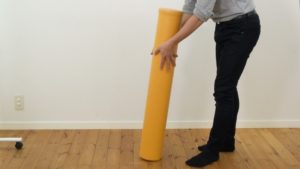
You would need to grab your body like I do with my hands. You would fall down, otherwise.
My hands’ support would be muscular support, and in this case you need excess muscular support, because you don’t need so much if you stand like this.

Now, correcting the position. This is advantageous positioning because it’s now possible for you to support your body with less muscular contraction.
But, you may leave your muscular support even in this positioning just the same as before. (Grab the pole) This could be happened because you get used to do this.

Your posture look nice, but you may still have excess muscle tension. You may get tired easily or still get pain. You may look a kind of stiff.
You should release this excess muscular tension in the advantageous position. Now, you stand upright advantageously. More comfortable, easy to breath, less pain, less burden, and good looking.

Did you get my point? It’s better that we get both advantageous positioning and advantageous quality of being in that position.
Now I show you how to be like that.
There are 4 processes you need to practice.
1. Place your head at the highest position, and rest the head
Let’s do one movement.
Bend the knees. Now you are moving up, but move with thinking like you bring your head upward by pushing the floor through the feet.
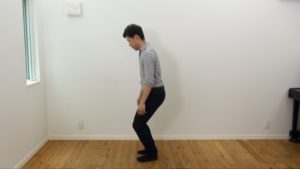
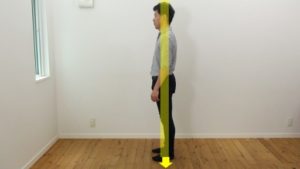
Try again. Bend the knees. Bring your head upward by pushing the floor. You felt pushing floor feeling, right? That’s the direction of your head needs to go. The true up.
Some people may place their head backward when they just think “up” or “straight”. It’s like this. That’s so back that it will make excess muscle tension in the neck and whole body.
Now, you need to rest your head there. Breath out easy like sighing, and turn the head to right and left while you are breathing.
This is resting condition of the head. If your head can move like this anytime with breathing, you are not holding the head tight with making excess muscle contraction.
I made the other video about “fixing head forward posture nice and easy way”, and I also showed how to support our head there.
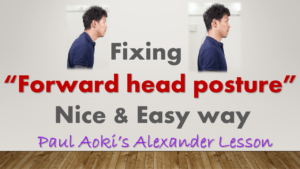
2. Make the pelvis stand
Second one is to make the pelvis stand.
What I mean by saying “the pelvis is standing” is that the pelvis is in the certain angle such that it lets the full weight of the upper body pass to the thigh bones, I mean the legs.
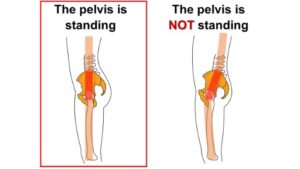
Let’s do another movement.
From your standing state, move the hip back and lean the upper body forward. You can look down. Your weight is still on your feet. Breath out easy. You may feel the weight in the front side of the thigh. Some people feel the weight on the knees.
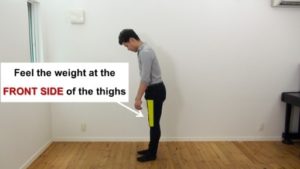
Now, this time, move your berry forward and lean the upper body backward a bit. Your weight is still on your feet. Breath out easy. You may feel the weight in the back side of the thigh.

There are some people who don’t get this feeling. I will give another way for these people later.
Anyway, these sense of weight are switching in this upper body movement like, “I got my weight on my front side of the thighs, and now I god my weight on my back side of the thighs.” We are going to use these senses.
There is switching point somewhere in the middle, and from there you can move the hip a little bit backward so that you feel your weight a little bit in the front side of the thigh.
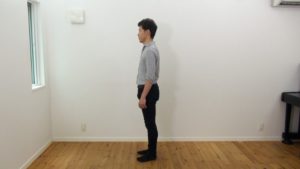
From the switching point to the point of a little bit weight in the front, this is the range of the area where the pelvis is in standing condition.
If you try to hold it there, the muscles around the hip joint has to work with excess muscle contraction. It’s better for you to allow the hip to move very small movement around there like this kind of hip backward swinging.
Now, stand upright with your own way. Which side of the thighs, front or back, do you feel your weight?
I think most of people feel the weight at the back side of the thighs. If so, your pelvis is not standing yet. It will be somewhat like this.
If you realize this, what you do is to move your hip back a little until the switching point or slightly feeling the weight in front. That’s how we make the pelvis stand.
Here we use objective evaluation, so it is possible to reproduce it anytime you want.
Usually in this kind of posture making, people try to stick with the way they are told to do it and hold the body there.
It’s because they don’t want to lose the sense or kinethetic feeling. However, again you don’t lose the sense in my way, so you don’t have to stick with it.
Another way of making the pelvis stand
Now, regarding the process of making the pelvis stand, there are some people who don’t get the weight feeling in their thigh.
For those people, try this instead. Movement is just the same.
When you move the hip backward and lean the upper body forward, you will feel the tension in the back muscles of the thighs. (These muscles are called the hamstrings.)
Now when you move the berry forward and lean the upper body backward, you will feel the tension in the front muscles of the thighs this time. (One of the big muscles are called the quadriceps femoris muscles.)
These are also switching in the swing movement like this. (Show) So, find out where the switching point is and stay there, or you can push your hip backward a bit, and stay the place where you feel the slight more muscle tension in the back of the thighs.
3. Standing with the whole feet
This is for making sure to stand in good weight balance, neither leaning backward nor leaning too forward, right in the middle.
Let’s do an experiment.
Try to stand with your whole body leaning forward a bit. Check your sense at the feet. You will notice you feel weight more on the toes than on the heel.

Now try to stand with your whole body leaning backward a bit. You will notice you feel weight more on the heel than on the toes, right?
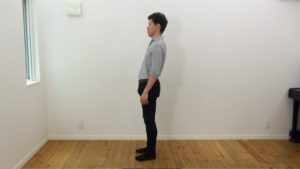
Then, find the place that you feel your weight throughout the feet. Neither inclined to the toe side, nor inclined to the heel side. Just the middle. You feel your weight at both the toe side and the heel side.
Think that you give your whole weight through the feet in that state, and breath out easy like sighing.
One small note. You feel your weight throughout the feet, but the pressure through the feet is not equally both at the toe side and heal side. It’s OK to feel a little more weight on the heal than on the toes. Think like not too much inclined to the heal side and feel certain weight still on the toe side.
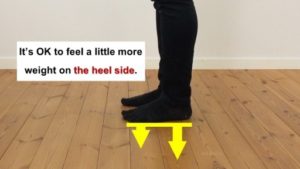
4. Rest the whole body on the floor

There is no big movement in this process, but I want you to have certain intentions.
Think of giving your weight of the body on the feet. Breath out easy from mouth like small sighing. Breath in easy as well. Do not rush to breath out and breath in.
Check whether your berry moves inflated and deflated along with breathing as if it moved automatically. If it moves like this, now you know that the abdominal muscles are not contracting in excess.
Check whether the head can move anytime, and whether the hip can move anytime as well. If you are not sure, you just move them.
combine 4 processes
I showed the 4 processes. Now what you need to do is to combine these 4 processes.
First, you change your position. Move the head upward and rest it at the highest position, making the pelvis stand, and stand with the whole feet receiving weight.
And then rest the body and head there. Breathing out easy like sighing, check the berry’s automatical movement, and turn your head to right and left with breathing and swing the hip backward. Be in the condition such as your head can move anytime and your hip can move anytime.
Now you are standing upright abvantageously.
You may feel that’s a lot to think about. For me, it is quite easy management because I have practiced many times.
You need to practice something if you control something as you wish.
Useful feedbacks
There are useful feedbacks you can check.
You might feel like you are leaning forward. Actually it is all right, and we should be so because it is how we are designed.
When we stand upright in the advantageous position, our center of the gravity of the body is in a little bit front of the fulcrum, in this case, the ankle joint. The vertical line of the center of the gravity of the body passes through the point where is in front of the ankle joint by 2 or 3 cm (about 1 inch).

This means that we are standing by receiving the force of falling forward. We don’t fall because the back muscles are keep working against this morment of force. That’s what we are supposed to do in the advantageous position.
So, it is OK for us to feel like leaning forward. We are just feeling the moment of force. However, we don’t look like we are leaning forward. It’s right on the top of the feet.
Now you can check some useful feedback to practice this condition.
The weight of your head can be felt at the front side of the neck where the top of the sturnum is. The weight of your head and chest can be felt at the berry or tummy where the guts are. The weight of your upper body can be felt at the front side of the thighs like you feel it when you make the pelvis stand, and you feel your weight on the shin bones, where is in front of the lower legs.
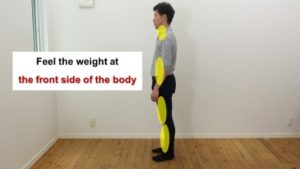
If you have problem to specify these senses, you might want to try the opposite positioning.
Stand like this. The pelvis leaning backward, and the head leaning backward. You will feel the weight of the head is at the back side of the neck. You will feel the weight of the chest and the head is at the lower back.

Then, do the 4 processes and come back to the advantageous upright standing. You might feel the weight in the front of the body more after this trial.
I am not suggesting leaning forward too much like your body visually lean forward. This is too far forward. Check the head position and check the weight of the whole feet. Only slight feeling of the weight in front is OK. You can check it with the mirror sometimes.
How to continue
If you need to stand upright for a while or you just want to stand upright for a while, you may need to redo these processes from time to time, so that you can continue the positioning and quality of resting.
There is one note for continuing this advantageous standing.
Try not to hold it tight, especially in the neck and the hip joints. If we hold it tight, the muscles around the joints have to work with excess muscle contraction.
It’s better for you to allow some movements like the head turn or the hip swing, or even berry movement through breathing as I showed before.
I show you how the bones are jointed at the joint like the hip joints.
Here is 2 dumbbells, and make 1 dumbbell place on the other just like the bones joints each other. Since the ends of these dumbbells are not flat, it will not stand on the other by itself. I need to support it with my hands.
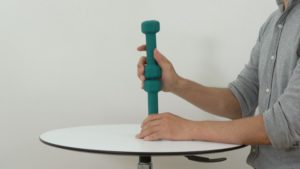
Our joints are mostly like this kind of structure. The bones won’t stand on the others just by itself, but the bones stand with the muscular support.
We have 2 ways to place this dumbbell on the other. One is just placing like this. It is minimumly supported, and so it moves some. The other way is to hold like this. It won’t move a bit, but it requires more pulling forces with my hands.
Since we can place the dumbbell on the other with the former way of using less support, we can say that the support in the latter way is in excess.
My hands support would be muscular support in the joint. So, like the latter case here, if we try to hold the joint like not moving a bit, the muscles around the joint have to work with excess muscle contraction.
To use the muscle contraction minimum we need to be like the former way. I mean that allowing some movements. What I am saying is that we sometimes intentionally create the condition of “allowing some movements” for minimum muscle contraction.
This is why I recommend you to allow some movements like the head turn or the hip swing or even the berry movement through breathing.
Small movement is just fine in such a way people around you wouldn’t notice the movements.
If we can manage these things, we are almost like a placed object, nice and calm. So, I call this process “Placing”. We will be comfortable with minimum muscle tension by “Placing”.
One more advise
Just one more advice for practising the advantegeous upright standing.
Since you will look for some senses like weight feeling or feeling floor, your attention would be drawn to inside of the body very easy. Then, you won’t be free enough.
It’s better that you also pay some attention to the outside or surroundings.
To do it, it is better to look at something, and ask yourself “what color is it?”
You don’t need to answer this question, but intentionally pay some attention to surroundings by looking at something while you manage these inside processes.
It is possible for us to manage both. It’s our natural state to pay attention to surroundings, or the activities we do. So, we just need to integrate both external attention and internal attention.
That’s it. You may need to explore these processes some times. Just enjoying the processes. I hope you get some useful ideas from this.
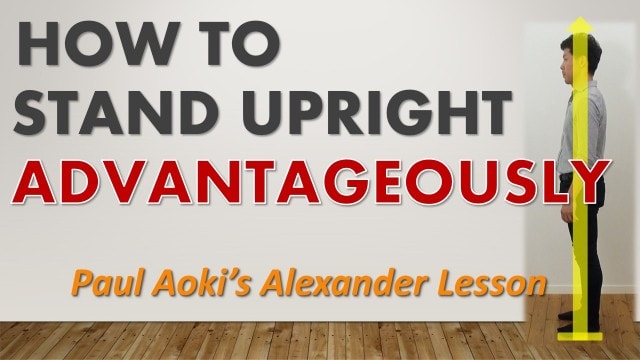

Comments